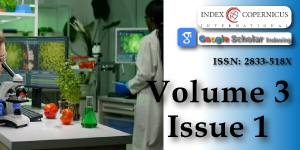Nanotherapeutic agent for cancer: Miracle or catastrophe
Main Article Content
Article Details
Copyright (c) 2019 Dhasmana A.

This work is licensed under a Creative Commons Attribution 4.0 International License.
Huang YW, Cambre M, Lee HJ. The toxicity of nanoparticles depends on multiple molecular and physicochemical mechanisms. Int J Mol Sci. 2017; 18: 2702. Ref.: http://bit.ly/2X6tA8B
Kim KY. Nanotechnology platforms and physiological challenges for cancer therapeutics. In Nano medicine in Cancer. 2017; 3: 27-46. Ref.: http://bit.ly/2LlLima
Wang Y, Yu L, Monopoli MP, Sandin P, Mahon E, et al. Nanomedicine: nanotechnology. Biol Med. 2015; 11: 313-327.
Pippa N, Demetzos C, Pispas S, editors. Drug Delivery Nanosystems: From Bioinspiration and Biomimetics to Clinical Applications. CRC Press; 2019. Ref.: http://bit.ly/2ZUdbWM
Wei T, Chen C, Liu J, Liu C, Posocco P, et al. Anticancer drug nanomicelles formed by self-assembling amphiphilic dendrimer to combat cancer drug resistance. Proc Natl Acad Sci U S A. 2015; 112: 2978-2983. Ref.: http://bit.ly/2xjDt8l
Karlsson J, Vaughan HJ, Green JJ. Biodegradable polymeric nanoparticles for therapeutic cancer treatments. Annu Rev Chem Biomol Eng. 2018; 7; 9: 105-127. Ref.: http://bit.ly/2FBHNoc
Zhang P, Wang J, Chen H, Zhao L, Chen B, et al. Tumor Microenvironment-Responsive Ultrasmall Nanodrug Generators with Enhanced Tumor Delivery and Penetration. J Am Chem Soc. 2018; 140: 14980-14989. Ref.: http://bit.ly/2xkcVDW
Liu T, Zeng L, Jiang W, Fu Y, Zheng W, et al. Rational design of cancer-targeted selenium nanoparticles to antagonize multidrug resistance in cancer cells. Nanomedicine. 2015; 11: 947-958. Ref.: http://bit.ly/2YhSSCb
Song J, Lin C, Yang X, Xie Y, Hu P, et al. Mitochondrial targeting nanodrugs self-assembled from 9-O-octadecyl substituted berberine derivative for cancer treatment by inducing mitochondrial apoptosis pathways. J Control Release. 2019; 294: 27-42. Ref.: http://bit.ly/2YryVso
Greenstein JP. Biochemistry of cancer. Elsevier. 2016; Ref.: http://bit.ly/2YkPUNg
Siegel R, DeSantis C, Virgo K, Stein K, Mariotto A, et al. Cancer treatment and survivorship statistics, 2012. CA Cancer J Clin. 2012; 62: 220-241. Ref.: http://bit.ly/2NdHHcn
Miller KD, Siegel RL, Lin CC, Mariotto AB, Kramer JL, et al. Cancer treatment and survivorship statistics, 2016. CA Cancer J Clin. 2016. 2016; 66: 271-289. Ref.: http://bit.ly/2XyLTaR
Schumacher TN, Schreiber RD. Neoantigens in cancer immunotherapy. Science. 2015; 348: 69-74. Ref.: http://bit.ly/31XS47H
Ahles TA, Root JC. Cognitive effects of cancer and cancer treatments. Annu Rev Clin Psychol. 2018; 14: 425-451. Ref.: http://bit.ly/2IRsMka
Heath JR, Davis ME. Nanotechnology and cancer. Annu Rev Med. 2008; 59: 251-265. Ref.: http://bit.ly/2xjDM2Z
Wang X, Yang L, Chen Z, Shin DM. Application of nanotechnology in cancer therapy and imaging. CA Cancer J Clin. 2008; 58: 97-110. Ref.: http://bit.ly/2YhI1Id
Shi J, Kantoff PW, Wooster R, Farokhzad OC. Cancer nanomedicine: progress, challenges and opportunities. Nat Rev Cancer. 2017; 17: 20. Ref.: http://bit.ly/2X30XZT
Jain RK. The next frontier of molecular medicine: delivery of therapeutics. Nature medicine. 1998 Jun;4(6):655., Allen TM. Ligand-targeted therapeutics in anticancer therapy. Nat Med. 2002; 2: 750. Ref.: http://bit.ly/2ZRvpbb
Nakamura Y, Mochida A, Choyke PL, Kobayashi H. Nanodrug delivery: is the enhanced permeability and retention effect sufficient for curing cancer? Bioconjug Chem. 2016; 27: 2225-2238. Ref.: http://bit.ly/2XGLSl0
Chen Q, Liang C, Wang C, Liu Z. An imagable and photothermal “Abraxane‐like” nanodrug for combination cancer therapy to treat subcutaneous and metastatic breast tumours. Adv Mater. 2015; 27: 903-910. Ref.: http://bit.ly/2J8EXb8
Fan W, Yung B, Huang P, Chen X. Nanotechnology for multimodal synergistic cancer therapy. Chem Rev. 2017; 117: 13566-13638. Ref.: http://bit.ly/2Yi9rOr
Sinha R, Kim GJ, Nie S, Shin DM. Nanotechnology in cancer therapeutics: bio conjugated nanoparticles for drug delivery. Molecular cancer therapeutics. 2006; 5: 1909-1917. Ref.: http://bit.ly/2IS8J54
Olov N, Bagheri‐Khoulenjani S, Mirzadeh H. Combinational drug delivery using nanocarriers for breast cancer treatments: A review. J Biomed Mater Res A. 2018; 106: 2272-2283. Ref.: http://bit.ly/2Nijbaj
Raza A, Rasheed T, Nabeel F, Hayat U, Bilal M, et al. Endogenous and Exogenous Stimuli-Responsive Drug Delivery Systems for Programmed Site-Specific Release. Molecules. 2019; 24: 1117. Ref.: http://bit.ly/2XflIX6
Alexis F, Rhee JW, Richie JP, Radovic-Moreno AF, Langer R, et al. New frontiers in nanotechnology for cancer treatment. Urol Oncol. 2008; 26: 74-85. Ref.: http://bit.ly/2xgI3Ev
Ferrari M. Cancer nanotechnology: opportunities and challenges. Nat Rev Cancer. 2005; 5: 161-171. Ref.: http://bit.ly/2Lqemcv
van Elk M, Murphy BP, Eufrasio-da-Silva T, O’Reilly DP, Vermonden T, et al. Nanomedicines for advanced cancer treatments: Transitioning towards responsive systems. Int J Pharm. 2016; 515: 132-164. Ref.: http://bit.ly/2ZUbxV2
Qin SY, Zhang AQ, Cheng SX, Rong L, Zhang XZ. Drug self-delivery systems for cancer therapy. Biomaterials. 2017; 112: 234-247. Ref.: http://bit.ly/3021xt1

